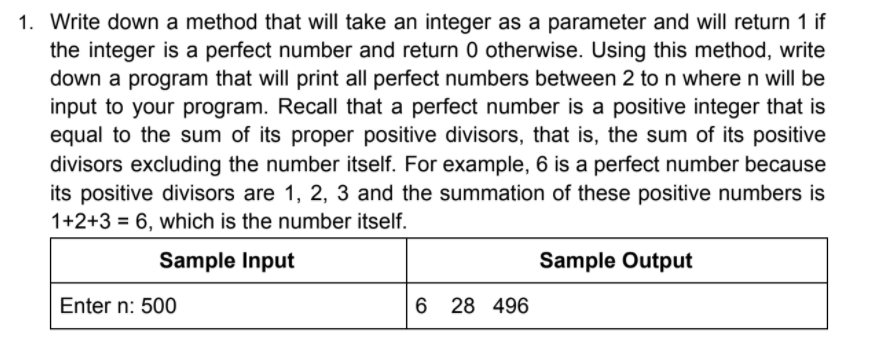1. Write down a method that will take an integer as a parameter and will return 1 if the integer is a perfect number and return 0 otherwise. Using this method, write down a program that will print all perfect numbers between 2 to n where n will be input to your program. Recall that a perfect number is a positive integer that is equal to the sum of its proper positive divisors, that is, the sum of its positive divisors excluding the number itself. For example, 6 is a perfect number because its positive divisors are 1, 2, 3 and the summation of these positive numbers is 1+2+3 = 6, which is the number itself. Sample Input Sample Output Enter n: 500 6 28 496
1. Write down a method that will take an integer as a parameter and will return 1 if the integer is a perfect number and return 0 otherwise. Using this method, write down a program that will print all perfect numbers between 2 to n where n will be input to your program. Recall that a perfect number is a positive integer that is equal to the sum of its proper positive divisors, that is, the sum of its positive divisors excluding the number itself. For example, 6 is a perfect number because its positive divisors are 1, 2, 3 and the summation of these positive numbers is 1+2+3 = 6, which is the number itself. Sample Input Sample Output Enter n: 500 6 28 496
Computer Networking: A Top-Down Approach (7th Edition)
7th Edition
ISBN:9780133594140
Author:James Kurose, Keith Ross
Publisher:James Kurose, Keith Ross
Chapter1: Computer Networks And The Internet
Section: Chapter Questions
Problem R1RQ: What is the difference between a host and an end system? List several different types of end...
Related questions
Question
write this code on java.

Transcribed Image Text:1. Write down a method that will take an integer as a parameter and will return 1 if
the integer is a perfect number and return 0 otherwise. Using this method, write
down a program that will print all perfect numbers between 2 to n where n will be
input to your program. Recall that a perfect number is a positive integer that is
equal to the sum of its proper positive divisors, that is, the sum of its positive
divisors excluding the number itself. For example, 6 is a perfect number because
its positive divisors are 1, 2, 3 and the summation of these positive numbers is
1+2+3 = 6, which is the number itself.
Sample Input
Sample Output
Enter n: 500
6 28 496
Expert Solution
This question has been solved!
Explore an expertly crafted, step-by-step solution for a thorough understanding of key concepts.
Step by step
Solved in 3 steps with 2 images

Recommended textbooks for you

Computer Networking: A Top-Down Approach (7th Edi…
Computer Engineering
ISBN:
9780133594140
Author:
James Kurose, Keith Ross
Publisher:
PEARSON

Computer Organization and Design MIPS Edition, Fi…
Computer Engineering
ISBN:
9780124077263
Author:
David A. Patterson, John L. Hennessy
Publisher:
Elsevier Science

Network+ Guide to Networks (MindTap Course List)
Computer Engineering
ISBN:
9781337569330
Author:
Jill West, Tamara Dean, Jean Andrews
Publisher:
Cengage Learning

Computer Networking: A Top-Down Approach (7th Edi…
Computer Engineering
ISBN:
9780133594140
Author:
James Kurose, Keith Ross
Publisher:
PEARSON

Computer Organization and Design MIPS Edition, Fi…
Computer Engineering
ISBN:
9780124077263
Author:
David A. Patterson, John L. Hennessy
Publisher:
Elsevier Science

Network+ Guide to Networks (MindTap Course List)
Computer Engineering
ISBN:
9781337569330
Author:
Jill West, Tamara Dean, Jean Andrews
Publisher:
Cengage Learning

Concepts of Database Management
Computer Engineering
ISBN:
9781337093422
Author:
Joy L. Starks, Philip J. Pratt, Mary Z. Last
Publisher:
Cengage Learning

Prelude to Programming
Computer Engineering
ISBN:
9780133750423
Author:
VENIT, Stewart
Publisher:
Pearson Education

Sc Business Data Communications and Networking, T…
Computer Engineering
ISBN:
9781119368830
Author:
FITZGERALD
Publisher:
WILEY